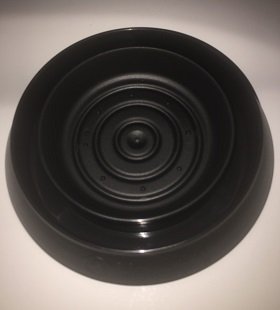Detecting Bed Bugs: Interceptors
The bed bug control industry has a spectrum full of techniques for not only exterminating bed bugs, but also detecting bed bugs. Different detection methods can generally be grouped in to three categories:
- passive interceptors and active traps [Pest Solution Services provides this]
- visual inspections by entomologist [Pest Solution Services provides this]
- canine scent detection [Pest Solution Services does NOT provide this]
This new series of articles under the title Detecting Bed Bugs will consist of articles that disect each of the categories above. This first article in the series analyzes bed bug interceptors.
Passive Interceptors
Devices that capture bed bugs and can be placed practically anywhere in a building or home (not just under the legs of beds or near beds) are known as passive interceptors. These are very simple devices that lack features such as lures or pheromones and they trap bed bugs, passively, by virtue of their design and manufacture material.
Physical Manifestation
Passive interceptors are usually manifested in bowl-shaped apparatus that is placed under the legs of a bed. It is important to note that they can be effective when placed anywhere in a building or home[1][2], not just under bed frame or furniture legs.

Bed bugs that crawl in cannot get out due to the inner material being a slippery plastic that allows no friction for crawling. Very simple, yet extremely successful mechanism that can detect bed bugs with great accuracy.
After this discussion of physical properties we turn our attention to more abstract properties using personal experience (more than 1000 bed bug inspections) and summarised statistical data and research cited throughout the text.
Detection Success Rate
The success rates of passive interceptors are outstanding – passive interceptors reflected the highest success rate in detecting bed bug infestations when compared to other detection methods in four separate field studies[3].
Further conclusions published in 2014 suggest passive interceptors detect low-level infestations with accuracies generally able to surpass 90% when left for more than a week.[2].
We must conclude, however that interceptors and visual inspections are neck and neck when it comes to detection success rate. Three of the four field studies (mentioned above and in [3]) compared visual inspections with passive interceptors. In one of such field comparisons (published 2015), visual inspections detected infestations that were missed by passive interceptors and only 81 of 209 apartments were visually inspected whereas 209 of 209 apartments had interceptors.[3][4]. And in the last of such field comparisons, visual inspections were limited and are described as “cursory” instead of “detailed”, and yet managed to only trail behind passive interceptors by a 17% accuracy difference[5].
Time Elapsed Until Detection
You must be thinking that with such high interceptor success rates, there is probably a catch! Indeed, there is. It turns out, bed bug detection via passive interceptors is not instantaneous; it’ll take a few nights. This is exactly what we discuss in this property.
In the case of interceptors, time elapsed until detection refers to the time taken for the passive interceptor to catch evidence of a bed bug infestation. In heavy infestations this time may only be 24 hours or less. In general, 2 weeks should pass with an empty interceptor in order to rule out an infestation.
Classes of Evidence Detected
When detecting a bed bug infestation, you are looking for 6 evidences. The first three would be considered living and the last three are non-living:
- Adult bed bugs
- Any life-cycle stage excluding eggs and adults
- Eggs
- Exoskeleton
- Fecal matter
- Bites
The main function of an interceptor is to detect the first 2 on the list. However, it is possible for the first 5 to be present in an interceptor only after the presence of the first 2. Therefore, we must judge the ability of the interceptor as a device that detects adult bed bugs and all stages of the life cycle of the bed bugs except the eggs (2 classes of evidence).
Our judgement is supported further when we will later see that build up of exoskeleton and eggs can help bed bugs escape the interceptors, thus it is only designed to truly detect 2 of the above classes of evidence.
Reliability (False Negatives/Positives)
It is possible for bed bug interceptors to catch other pests suchs as beetles, small spiders. In the case the interceptor catches a small insect that resembles a bed bug, then without verification the homeowner might assume it is a bed bug and so this is a scenario that some may count as a false positive.
False negatives are much less plausible. It rarerly occurs that interceptors were mantained for 2 weeks and caught nothing in a house that was actually infested during those 2 weeks. This would technically count as a false negative, however, it is impractical.
Quality, Costs, and Maintenance
The quality of interceptors is relatively same across the various manufacturers and sellers. The basic function remains the same and the costs can range depending on whether you will be buying multiple packs or in bulk. Four interceptors for one bed can cost slightly under $30 CAD.

Although this makes interceptors economic for prevention, shared properties, frequent travellers (also: when you have no bites or just did a treatment for your house), depending on the number of furniture you have, a similar price can generate instantaneous results with a visual inspection.
Lastly, maintenance is important depending on manufacturers. Some have a substance that makes the inside of the interceptor slippery so bed bugs can crawl out – this substance must be replenished[1] where as others are made of plastic that varies in roughness.
Plastic traps are superior than replenish traps as they call for minimal maintenance (like regularly wiping the trap clean of dust that may be on the inner smooth plastic). Rough plastic on the exterior of the trap allows bed bugs to climb up and in to the interceptor and smooth plastic on the inside of the interceptor traps them there. Plastic traps need to be wiped of any dust from the inside (smooth plastic part) in order to keep the friction as minimal as possible so the bed bugs can’t climb out[1].
Conclusions
With high success rates and low costs paired with low reliability (confirming catches) and slight maintenance, it is rational to use passive interceptors as a preventative measure to detect infestations as soon as they happen. And even more so as a confirmation method to confirm that a treatment has been successful by using interceptors for weeks after the treatment. Therefore, interceptors are best used for homeowners (frequent travellers, shared properties) who wish for the extra caution and early detection, and also as a follow-up measure for ensuring a treatment has been successful.
To conclude all of the above information, we can condense it in to pros and cons. The list below lists the pros and cons of bed bug interceptors as a detection method, with each point taken from its respective place in the above discussion. Citations in this summarised list are omitted and should be found in the above paragraphs, if needed.
- PRO: Small physical design can be placed and is effective anywhere in a building or home, not just for legs of a bed frame.
- PRO: When left for more than a week, accuracy in infestation detection can surpass 90%.
- PRO: Very cheap option for prevention and early detection for frequent travellers, shared properties, and those paranoid.
- PRO: Simple maintenance of dusting regularly.
- CON: Infestation detection is not instantaneous – may take a few nights or at most a couple of weeks (assuming no new infestation arises in those 2 weeks).
- CON: Designed to detect and functions to catch only 2 classes of evidence: adult bed bugs and all other life stages excluding eggs
- CON: You may need to verify doubtful catchings from a professional to prevent false positives.
References
- [1] S. L. Doggett, D. M. Miller, C.-Y. Lee, and D. Miller, Advances in the Biology and Management of Modern Bed Bugs. Newark: John Wiley & Sons, Incorporated, 2018, pp. 247.
- [2] S. L. Doggett, D. M. Miller, C.-Y. Lee, and D. Miller, Advances in the Biology and Management of Modern Bed Bugs. Newark: John Wiley & Sons, Incorporated, 2018, pp. 249.
- [3] S. L. Doggett, D. M. Miller, C.-Y. Lee, and D. Miller, Advances in the Biology and Management of Modern Bed Bugs. Newark: John Wiley & Sons, Incorporated, 2018, pp. 249-250.
- [4] R. A. Cooper, C. Wang, and N. Singh, “Evaluation of a model community-wide bed bug management program in affordable housing,” Pest management science, vol. 72, no. 1, pp. 45-56, 2016, doi: 10.1002/ps.3982.
- [5] S. L. Doggett, D. M. Miller, C.-Y. Lee, and D. Miller, Advances in the Biology and Management of Modern Bed Bugs. Newark: John Wiley & Sons, Incorporated, 2018, pp. 250.


